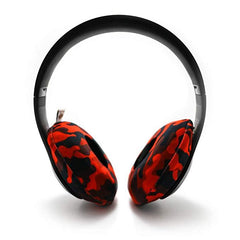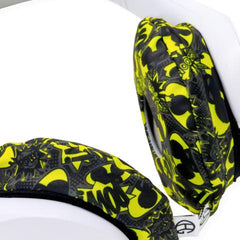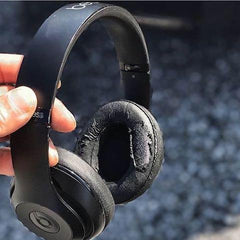Are Noise-Cancelling Headphones Safe?

In an increasingly loud world, they’re more popular than ever but are noise-cancelling headphones safe?
There are two types of noise cancellation: passive and active.
All headphones have passive noise-cancellation as the cushion’s padding, sitting against the ear, will muffle ambient sounds.
Active noise-cancelling headphones are different. Whilst still providing passive cancellation, they also use technology to block background noise. A tiny microphone built inside the earpiece listens out for incoming noises and then creates an opposing soundwave cancelling out incoming sounds before they reach the ear.
The value of ANC is clear when you consider why Amar Bose - founder of Bose - first began working on the technology.
On a Trans-Atlantic flight in 1978, Amar Bose was frustrated that the airline-issued headphones did nothing to block out the drone of the aircraft’s engines. Unable to hear much even with the volume jacked-up, he began sketching ideas on how to reduce unwanted ambient noise on a napkin. Once he’d returned to the US, Bose set-up the Noise Reduction Technology Group. Ten years later and the world’s first active-noise-cancelling headphone was manufactured.
Every day is a school day.
Today, Bose is still known for its noise-cancelling headphones and the Bose QuietComfort 35 II is one of its most recent and most popular models.But if Bose isn’t your thing, then we’d recommend taking a look at the Sony WH1000MX3 Wireless headphone which has been touted as ‘the best noise-cancelling headphone in the world’.
In today’s increasingly loud world noise-cancelling technology can be a valuable asset. Increased volume can trigger the body’s stress response and for those of us living in cities and large towns, noise pollution could be increasing our risk of heart disease and strokes.
But are noise-cancelling headphones safe to use regularly?
Yes, they’re safe to use.
Some people have raised concerns that exposure to consecutive soundwaves could be bad for our hearing. After all, we’re told not to listen to music for extended periods without a break and isn’t that the same thing?
No, not really.

There’s no real evidence that inaudible soundwaves can damage your hearing. Hearing loss tends to occur when a person listens to loud noises above safe levels for extended periods of time. Anything louder than around 85 decibels is considered loud enough to be harmful to your hearing. Experts recommend that when listening through a personal device the volume should be no more than at 60% with a break every 60 minutes. Worryingly, hearing loss in teenagers is up 30% since the 1990s something that’s believed to be down to increased volume for extended periods of time.
If there’s no clear overt danger to wearing active noise-cancelling headphones, then there’s an obvious benefit: if our headphones can block out ambient noise then we’re less likely to crank up the volume to unsafe levels.
There might not be an overt danger to hearing but a number of people have had an adverse reaction to wearing ANC cans.
Mild headaches and nausea have been attributed to the use of noise-cancelling headphones. There’s been a medical study, too, which looked at whether wearing ANC headphones were a contributing factor to a woman who developed a common form of vertigo after wearing a pair for 12 hours.
The Wall Street Journal had an interesting health Q and A some years back, too. A reader had written in to say they felt queasy each time they put them on and at one stage had to lie down before being physically sick. They wondered if the Bose QuietComfort 35 II were to blame.
The WSJ wrote the following:
“Sarah Stackpole, a New York ear, nose and throat doctor, speculates that the sound waves that cancel each other out may still transmit enough very low-frequency vibrations to stimulate the balance receptors that are connected to the hearing hair cells in the inner ear. These vibrations are akin to those caused by blast explosions or barotrauma in scuba diving, but much less forceful, she says. The disequilibrium that some people may feel from this is made worse because the vibrations falsely signal that the head is moving, but the eyes report that the head is stationary. Those mixed signals make the headphone wearer feel dizzy.”

There’s a thread on Reddit where noise-cancelling headphones are discussed as being connected to a general feeling of being unwell and even a cursory Google search suggests that this is something that has genuinely affected a number of people.
Sensitivity to ANC headphones could be similar to motion sickness. Perhaps that why some people suffer with it and others don’t. If you’re worried it might be worth testing a pair out before you buy them.
There’s a further point to be made, too. In the past, we’ve recommended noise-cancelling headphones for the gym. We’ve recommended them, too, for exercise outside but that’s where the issue of whether ANC is ‘safe’ becomes something else entirely.
It’s understandable why we’d want to reduce ambient noise when we’re working out. Music can increase athletic performance and we want to pass the time as we exercise. In the gym, using ANC will probably be fine. It’s a controlled environment with limited dangers. When we’re outside, however, working out on the road or on trails, our ability to hear is vital to our safety. If we isolate ourselves from the dangers around us, we put ourselves at risk of harm. Therefore, it becomes not just about whether ANC headphones cause us harm but whether our decision to wear them puts us in danger. That’s a choice you can make for yourself but it’s worth considering wearing open-back on-ear headphones for your workout as these let sound filter through.
Of course, ANC technology does different things in different headphones, too. For example, the newly released Microsoft Surface headphone allows you to dial up or dial down the noise-cancellation depending on what you prefer at that time.
You might consider passive noise-cancellation for your workout. A good pair of headphones whether on-ear or over-ear should have enough cushioning to naturally isolate sound.
If you’re still tempted by over-ear noise-cancelling headphones, then there are some great models available and all with different features and at different price points. If you’re a regular traveller as well as a gym-user, then noise-cancelling makes a lot of sense just be sure to add your sweat-proof headphone covers on before you start working out.






